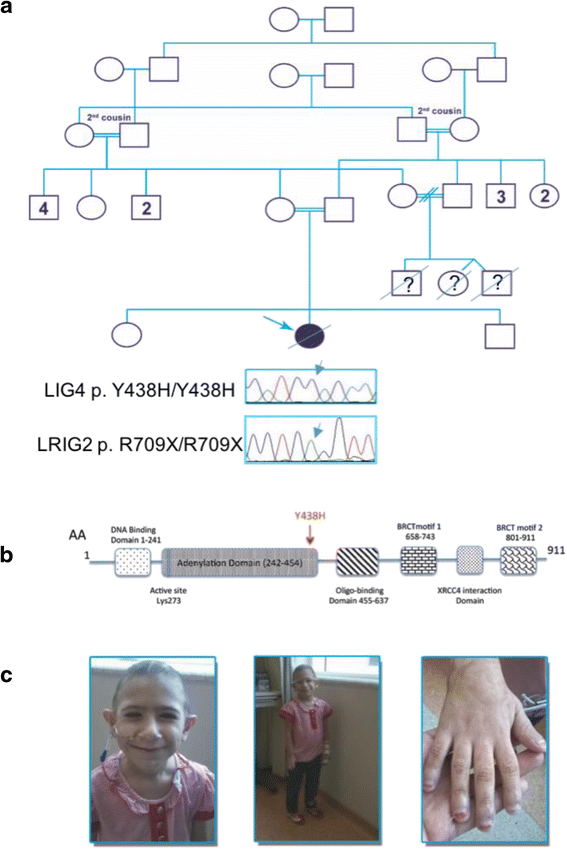Two hits in one: whole genome sequencing unveils LIG4 syndrome and urofacial syndrome in a case report of a child with complex phenotype
- PMID: 27855655
- PMCID: PMC5114772
- DOI: 10.1186/s12881-016-0346-7
Two hits in one: whole genome sequencing unveils LIG4 syndrome and urofacial syndrome in a case report of a child with complex phenotype
Abstract
Background: Ligase IV syndrome, a hereditary disease associated with compromised DNA damage response mechanisms, and Urofacial syndrome, caused by an impairment of neural cell signaling, are both rare genetic disorders, whose reports in literature are limited. We describe the first case combining both disorders in a specific phenotype.
Case presentation: We report a case of a 7-year old girl presenting with a complex phenotype characterized by multiple congenital abnormalities and dysmorphic features, microcephaly, short stature, combined immunodeficiency and severe vesicoureteral reflux. Whole Genome Sequencing was performed and a novel ligase IV homozygous missense c.T1312C/p.Y438H mutation was detected, and is believed to be responsible for most of the clinical features of the child, except vesicoureteral reflux which has not been previously described for ligase IV deficiency. However, we observed a second rare damaging (nonsense) homozygous mutation (c.C2125T/p.R709X) in the leucine-rich repeats and immunoglobulin-like domains 2 gene that encodes a protein implicated in neural cell signaling and oncogenesis. Interestingly, this mutation has recently been reported as pathogenic and causing urofacial syndrome, typically displaying vesicoureteral reflux. Thus, this second mutation completes the missing genetic explanation for this intriguing clinical puzzle. We verified that both mutations fit an autosomal recessive inheritance model due to extensive consanguinity.
Conclusions: We successfully identified a novel ligase IV mutation, causing ligase IV syndrome, and an additional rare leucine-rich repeats and immunoglobulin-like domains 2 gene nonsense mutation, in the context of multiple autosomal recessive conditions due to extensive consanguinity. This work demonstrates the utility of Whole Genome Sequencing data in clinical diagnosis in such cases where the combination of multiple rare phenotypes results in very intricate clinical pictures. It also reports a novel causative mutation and a clinical phenotype, which will help in better defining the essential features of both ligase IV and leucine-rich repeats and immunoglobulin-like domains 2 deficiency syndromes.
Keywords: Case report; Immunodeficiency; LIG4; LRIG2; Microcephaly; Vesicoureteral reflux; Whole genome sequencing.
Figures

Similar articles
-
Ligase IV syndrome can present with microcephaly and radial ray anomalies similar to Fanconi anaemia plus fatal kidney malformations.Eur J Med Genet. 2020 Sep;63(9):103974. doi: 10.1016/j.ejmg.2020.103974. Epub 2020 Jun 12. Eur J Med Genet. 2020. PMID: 32534991 Free PMC article.
-
A Novel Missense LIG4 Mutation in a Patient With a Phenotype Mimicking Behçet's Disease.J Clin Immunol. 2019 Jan;39(1):99-105. doi: 10.1007/s10875-018-0587-7. Epub 2019 Jan 8. J Clin Immunol. 2019. PMID: 30617623
-
Novel compound heterozygous DNA ligase IV mutations in an adolescent with a slowly-progressing radiosensitive-severe combined immunodeficiency.Clin Immunol. 2015 Oct;160(2):255-60. doi: 10.1016/j.clim.2015.07.004. Epub 2015 Jul 11. Clin Immunol. 2015. PMID: 26172957
-
Clinical and genetic characteristics for the Urofacial Syndrome (UFS).Int J Clin Exp Pathol. 2014 Apr 15;7(5):1842-8. eCollection 2014. Int J Clin Exp Pathol. 2014. PMID: 24966895 Free PMC article. Review.
-
[LIG4 syndrome: a report of four cases and literature review].Zhonghua Er Ke Za Zhi. 2019 Mar 2;57(3):217-221. doi: 10.3760/cma.j.issn.0578-1310.2019.03.012. Zhonghua Er Ke Za Zhi. 2019. PMID: 30818900 Review. Chinese.
Cited by
-
Hypertonia, Microcephaly and Hyperkalaemia in a Neonate: Coexistence of Neurodevelopmental Disorder and Adrenal Insufficiency.Iran J Child Neurol. 2022 Summer;16(3):223-228. doi: 10.22037/ijcn.v16i4.34348. Epub 2022 Jul 16. Iran J Child Neurol. 2022. PMID: 36204440 Free PMC article.
-
Clinical genetics and genomic medicine in Qatar.Mol Genet Genomic Med. 2018 Sep;6(5):702-712. doi: 10.1002/mgg3.474. Mol Genet Genomic Med. 2018. PMID: 30264509 Free PMC article.
-
Congenital Disorders of the Human Urinary Tract: Recent Insights From Genetic and Molecular Studies.Front Pediatr. 2019 Apr 11;7:136. doi: 10.3389/fped.2019.00136. eCollection 2019. Front Pediatr. 2019. PMID: 31032239 Free PMC article. Review.
-
Ligase IV syndrome can present with microcephaly and radial ray anomalies similar to Fanconi anaemia plus fatal kidney malformations.Eur J Med Genet. 2020 Sep;63(9):103974. doi: 10.1016/j.ejmg.2020.103974. Epub 2020 Jun 12. Eur J Med Genet. 2020. PMID: 32534991 Free PMC article.
-
Fatal familial insomnia with abnormal signals on routine MRI: a case report and literature review.BMC Neurol. 2017 May 26;17(1):104. doi: 10.1186/s12883-017-0886-2. BMC Neurol. 2017. PMID: 28549449 Free PMC article. Review.
References
Publication types
MeSH terms
Substances
Supplementary concepts
LinkOut - more resources
Full Text Sources
Other Literature Sources
Medical
Research Materials

